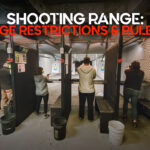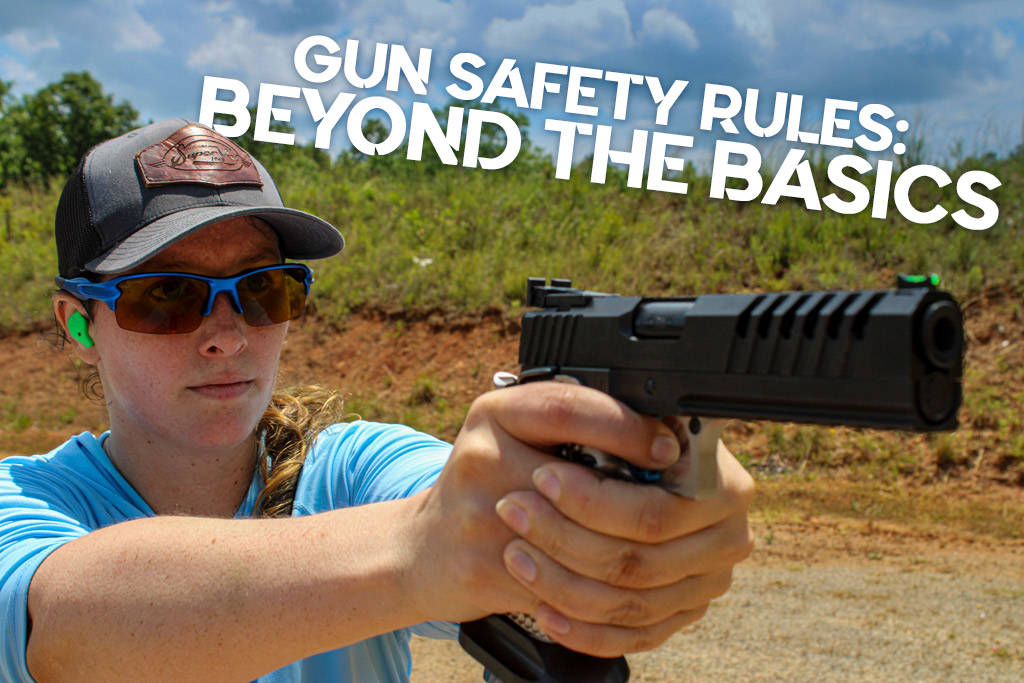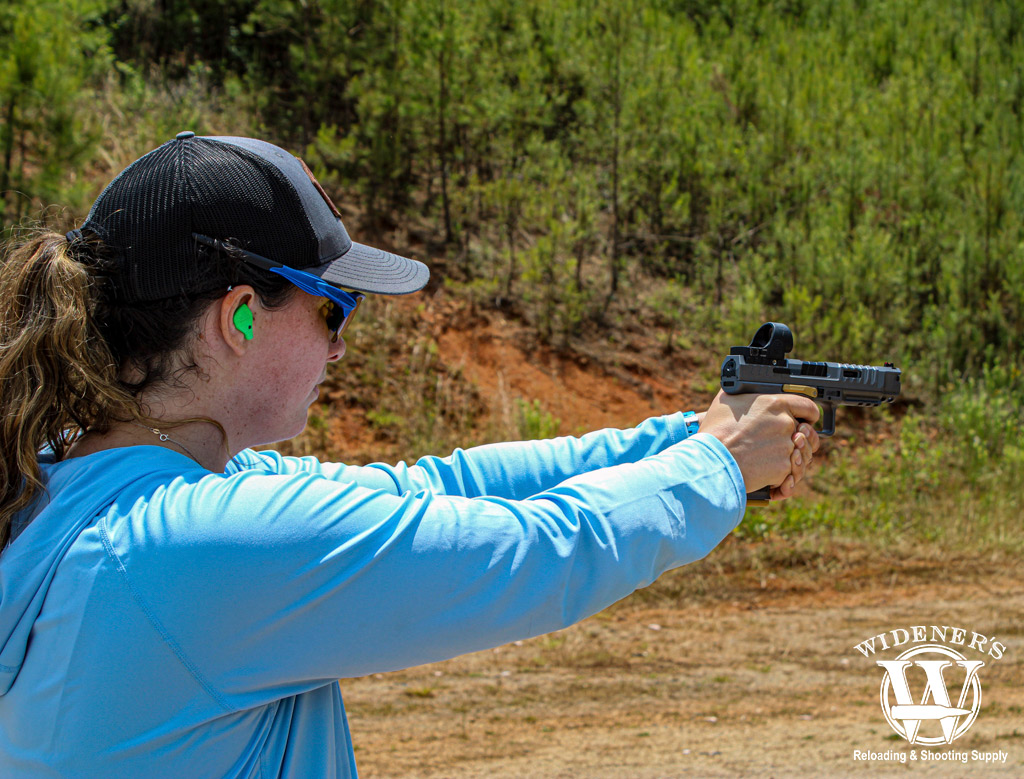

Guest Writer: Kenzie Fitzpatrick
Talking about gun safety rules isn’t riveting. However, it’s your responsibility as a gun owner to prioritize safety. There’s no such thing as being too educated about gun safety or being too cautious around firearms. I handle firearms daily, spending a lot of time at shooting ranges, matches, tradeshows, and other firearm-related events.
Unfortunately, I constantly see people being lax about their gun safety discipline. I see them not keeping their finger off the trigger, not checking if the gun is loaded, and not giving firearms the respect they deserve. Some of the worst offenders of poor firearm safety are long-time gun owners who can’t check their egos at the door.
Every gun owner can be more safety-conscious, and reviewing firearm safety rules and recommendations is never wrong. While the first four rules of firearm safety are the standard within the industry and should be put into practice every time you pick up a gun, there are a few other recommendations that’ll make you a professional at gun safety. Let’s take a look at these gun safety rules below:
Ten Gun Safety Rules

Always treat all guns as if they are loaded. Keep your finger off the trigger and the muzzle pointed in a safe direction.
1. Treat All Guns As If They’re Loaded
If someone hands you a gun, you and only you are responsible for checking if that gun is unloaded. Always check for yourself even if someone gives you a gun and tells you it’s empty. I don’t care if Jerry Miculek himself handed you a pistol and told you it was clear; you always check the gun yourself.
2. Always Keep Your Muzzle Pointed In A Safe Direction
While most of us have heard this gun safety rule countless times, have you thought about this with fake guns, plastic squirt guns, and other weapons? Building habits happens quickly, and one you can create for yourself without realizing it is pointing fake guns or weapons at people. This can easily carry over to when you have a real firearm in your hand. This scenario is especially common with children who don’t understand the difference between real and fake guns.
3. Keep Your Finger Off The Trigger Until You’re Ready To Shoot
The pressure needed to pull a trigger can be anywhere from a few ounces to 13 pounds for a revolver. No gun will fire without someone pulling the trigger, whether you have a shotgun, rifle, or pistol. The last line of defense to keep a firearm from going off when you don’t want it to is keeping your finger off the trigger until you’re ready to fire. This rule is the most important in my mind.
Even if you’re not following rules 1 and 2, rule number 3 should keep you from doing something you didn’t mean to do. (Please follow all the rules, but keeping your finger off the trigger until you’re ready to shoot at your intended target is the best way to prevent a firearm incident.)
4. Know Your Target & What’s Beyond It
From hunting to recreational shooting, you should always know what’s behind your target and what trajectory your bullet will take if you miss the mark. When hunting (especially on public land), you need to know where fellow hunters have set up, so you’re not shooting toward another blind or stand. Furthermore, if you want to kill only a buck, but a doe is in your line of fire, you shouldn’t take the shot until the doe is out of the way.
On many ranges, shooting bays are built on both sides of a berm, meaning you’re shooting directly into the berm the person on the other side is shooting at. Most people don’t know that ammunition can “skip” over a berm if you hit too low. This issue occurs when people set up their targets at the wrong height. Bullets then penetrate the target and keep moving. In this scenario, knowing what’s beyond your target and how high you should set it to ensure your bullets can’t skip over the berm is essential.
5. Always Wear Eye & Ear Protection When Shooting
While gun safety is typically about how to keep others safe, this rule will protect your eyes and ears. You only get one set of eyes and one set of ears in your lifetime. Why take the chance of losing your hearing or sight? At the most basic level, you should have some kind of shooting decibel-rated hearing protection and a pair of glasses to protect your eyes.
It doesn’t matter if you are actively shooting or not–always wear both. Ricochets from steel targets fly further than you think, and many friends and I have gotten hit with shrapnel from three bays over. One shot makes enough sound to damage your hearing permanently. I recommend shooting-specific ear protection with the highest decibel rating you can afford and wrap-around eye protection that is ANSI certified.
6. Know Your Gun Inside & Out

If you own a gun, you should know how to disassemble and assemble it safely, and perform regular maintenance.
All gun owners should know how to disassemble and assemble the firearms they own without assistance. Starting out, watch as many YouTube videos as necessary and ask for help from those who know how to strip the guns you own.
Once you understand how your gun comes apart, learn more about how it functions. Is it single action only? A striker-fired weapon? A lever action? A break action? Learn how to clean the magazines for the gun. Watch videos about how to replace worn parts on your own. The more knowledgeable you are about your weapons, the better. If you can explain to someone else how your gun works, you have successfully learned about your firearm.
7. Maintain Your Firearm
A firearm is a tool. Just like any device or machine you own, it needs regular maintenance. You alone are responsible for the condition of your firearm. Be sure to clean the gun correctly and often. Always keep your weapons lubricated and replace worn parts as needed. If a gun gets wet or you’re storing it long-term, make sure they’re dry and store it in a dry environment. Nothing kills firearms faster than rust. Part of gun safety is ensuring your weapon is safe and can function correctly, so no one gets hurt while you’re shooting.
8. Learn How To Clear Common Malfunctions
Malfunctions are part of firearm ownership. If you rarely shoot, you may not encounter all of the varieties, but you’ll surely come across one or two. There’s no guarantee that you’ll always have someone with you to help, so I strongly encourage every gun owner to learn how to clear malfunctions on their own. Malfunctions can be dangerous, especially if you ignore gun safety rules while clearing malfunctions.
Stovepipes, double-feeds, and light primer strikes can all cause confusion and are some of the most common issues you may encounter. A more serious problem is getting a squib load you must hammer out using a squib rod. Watch videos on the most common firearms malfunctions and how to clear them.
9. Check Your Firearms’ Compatibility With Ammunition
Especially now, you should know what ammunition your firearm is rated for. From hollow points to full metal jackets, some guns will not function or fire some ammunition, while others can’t handle the extra pressure of others. Always read your manual to see what the weapon can fire, especially +P and +P+ ammunition. Bullet grain weight and ammunition velocity can also affect a firearm’s accuracy and felt recoil. Learn what ammo works best in your gun and what its limits are.
10. Take A Firearms Class
The best thing you can do to bolster your gun safety knowledge is to take a firearms class. Education is key to safe gun handling, whether it’s a beginner or advanced course. Every gun owner should at least take an introductory firearms course. Every gun owner who chooses to carry a gun daily should take defensive firearm training classes, a firearms class incorporating movement, and a self-defense course that doesn’t use a firearm. You should do this continuously throughout your life as a gun owner.
Gun Safety Rules Are For Everyone

Learn the gun safety rules outlined in this article, develop good habits, and teach others.
Gun safety is everyone’s responsibility. It’s not just the purview of the range owner or officer but of every person on the range. If you see someone breaking a safety rule, don’t be afraid to say something. Especially if their unsafe actions could hurt themselves or another person. Everyone wants to have a great experience at the gun range, let’s all agree to be responsible gun owners and follow the rules!


